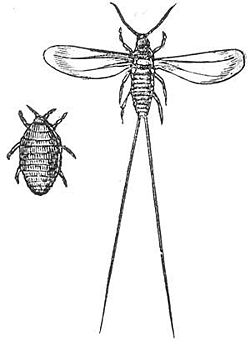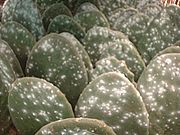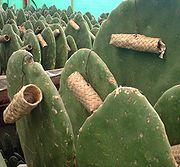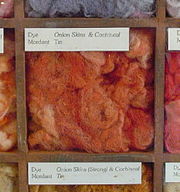
Cochineal
About this schools Wikipedia selection
This selection is made for schools by a children's charity read more. SOS Children has looked after children in Africa for forty years. Can you help their work in Africa?
| Cochineal | |
|---|---|
 |
|
| Female (left) and male (right) Cochineals. | |
| Scientific classification | |
| Domain: | Eukaryota |
| Kingdom: | Animalia |
| Phylum: | Arthropoda |
| Class: | Insecta |
| Order: | Hemiptera |
| Family: | Dactylopiidae |
| Genus: | Dactylopius |
| Species: | D. coccus |
| Binomial name | |
| Dactylopius coccus Costa, 1835 |
|
| Synonyms | |
|
Coccus cacti Linnaeus, 1758 |
|
Cochineal is the name of both crimson or carmine dye and the cochineal insect (Dactylopius coccus), a scale insect in the suborder Sternorrhyncha, from which the dye is derived. There are other species in the genus Dactylopius which can be used to produce cochineal extract, but they are extremely difficult to distinguish from D. coccus, even for expert taxonomists, and the latter scientific name (and the use of the term "cochineal insect") is therefore commonly used when one is actually referring to other biological species; suffice it to say that the reader should be aware that there is more than one cochineal insect. The primary biological distinctions between species are minor differences in host plant preferences, in addition to very different geographic distributions. D. coccus itself is native to tropical and subtropical South America and Mexico.
This type of insect, a primarily sessile parasite, lives on cacti from the genus Opuntia, feeding on moisture and nutrients in the cacti. The insect produces carminic acid which deters predation by other insects. Carminic acid can be extracted from the insect's body and eggs to make the dye. Cochineal is primarily used as a food colouring and for cosmetics.
After synthetic pigments and dyes such as alizarin were invented in the late 19th century, natural-dye production gradually diminished. However, current health concerns over artificial food additives have renewed the popularity of cochineal dyes, and the increased demand has made cultivation of the insect profitable again.
History
The cochineal dye was used by the Aztec and Maya peoples of Central and North America. Eleven cities conquered by Montezuma in the 15th century paid a yearly tribute of 2000 decorated cotton blankets and 40 bags of cochineal dye each. During the colonial period the production of cochineal (grana fina) grew rapidly. Produced almost exclusively in Oaxaca, Mexico by indigenous producers, cochineal became Mexico's second most valued export after silver. The dyestuff was consumed throughout Europe and was so highly prized that its price was regularly quoted on the London and Amsterdam Commodity Exchanges.
After the Mexican War of Independence in 1810–1821, the Mexican monopoly on cochineal came to an end. Large scale production of cochineal emerged especially in Guatemala and the Canary Islands. The demand for cochineal fell sharply with the appearance on the market of alizarin crimson and many other artificial dyes discovered in Europe in the middle of the 19th century, causing a significant financial shock in Spain as a major industry almost ceased to exist. The delicate manual labor required for the breeding of the insect could not compete with the modern methods of the new industry and even less so with the lowering of production costs. The "tuna blood" dye (from the Mexican name for the Opuntia fruit) stopped being used and trade in cochineal almost totally disappeared in the course of the 20th century. The breeding of the cochineal insect has been done mainly for the purposes of maintaining the tradition rather than to satisfy any sort of demand.
In recent years it has become commercially valuable again, though most consumers are unaware that the phrases "cochineal extract", "carmine", "crimson lake", "natural red 4", "C.I. 75470", "E120", or even "natural colouring" refer to a dye that is derived from an insect. One reason for its popularity is that, unlike many commercial synthetic red dyes, it is not toxic or carcinogenic. However, the dye can induce an anaphylactic shock reaction in a small number of people.
Biology
Cochineal insects are soft-bodied, flat, oval-shaped scale insects. The females, wingless and about 5 mm (0.2 in) long, cluster on cactus pads. They penetrate the cactus with their beak-like mouthparts and feed on its juices, remaining immobile. After mating, the fertilized female increases in size and gives birth to tiny nymphs. The nymphs secrete a waxy white substance over their bodies for protection from water and excessive sun. This substance makes the cochineal insect appear white or grey from the outside, though the body of the insect and its nymphs produces the red pigment, which makes the insides of the insect look dark purple. Adult males can be distinguished from females by their diminutive size and their wings.
It is in the nymph stage (also called the crawler stage) that the cochineal disperses. The juveniles move to a feeding spot and produce long wax filaments. Later they move to the edge of the cactus pad where the wind catches the wax filaments and carries the cochineals to a new host. These individuals establish feeding sites on the new host and produce a new generation of cochineals. Male nymphs feed on the cactus until they reach sexual maturity; when they mature they cannot feed at all and live only long enough to fertilize the eggs. They are therefore seldom observed.
Host cacti
Dactylopius coccus is native to tropical and subtropical South America and Mexico, where their host cacti grow natively. They have been introduced to Spain, the Canary Islands, Algiers and Australia along with their host cacti; and Eritrea, where their host cacti were already abundant. There are 150 species of Opuntia cacti, and while it is possible to cultivate cochineal on almost all of them, the best to use is Opuntia ficus-indica. All of the host plants of cochineal colonies were identified as species of Opuntia including Opuntia amyclaea, O. atropes, O. cantabrigiensis, O. brasilienis, O. ficus-indica, O. fuliginosa, O. jaliscana, O. leucotricha, O. lindheimeri, O. microdasys, O. megacantha, O. pilifera, O. robusta, O. sarca, O. schikendantzii, O. stricta, O. streptacantha, and O. tomentosa. Feeding cochineals can damage the cacti, sometimes killing their host. Cochineals other than D. coccus will feed on many of the same Opuntia species, and it is likely that the wide range of hosts reported for the former species is because of the difficulty in distinguishing it from these other, less common species.
Farming
There are two methods of farming cochineal: traditional and controlled. Cochineals are farmed in the traditional method by planting infected cactus pads or infecting existing cacti with cochineals and harvesting the insects by hand. The controlled method uses small baskets called Zapotec nests placed on host cacti. The baskets contain clean, fertile females which leave the nests and settle on the cactus to await insemination by the males. In both cases the cochineals have to be protected from predators, cold and rain. The complete cycle lasts 3 months during which the cacti are kept at a constant temperature of 27 °C. Once the cochineals have finished the cycle, the new cochineals are ready to begin the cycle again or to be dried for dye production.
To produce dye from cochineals, the insects are collected when they are approximately ninety days old. Harvesting the insects is labor-intensive as they must be individually knocked, brushed or picked from the cacti and placed into bags. The insects are gathered by small groups of collectors who sell them to local processors or exporters.
Several natural enemies can reduce the population of the insect on its cacti hosts. Of all the predators, insects seem to be the most important group. Insects and their larvae such as pyralid moths (order Lepidoptera), which destroy the cactus, and predators such as lady bugs (Coleoptera), various Diptera (such as Syrphidae and Chamaemyiidae), lacewings ( Neuroptera) and ants (Hymenoptera) have been identified, as well as numerous parasitic wasps. Many birds; human- commensal rodents, especially rats; and reptiles also prey on cochineal insects. In regions dependent on cochineal production, pest control measures have to be taken seriously. For small-scale cultivation manual methods of control have proved to be the most effective and safe. For large-scale cultivation advanced pest control methods have to be developed, including alternative bioinsecticides or traps with pheromones.
Farming in Australia
Prickly pear was first taken to Australia to start a cochineal dye industry in 1788, when Captain Arthur Phillip collected a number of cochineal-infested plants from Brazil on his way to establish the first European settlement at Botany Bay (part of which is now Sydney, New South Wales). At that time, Spain and Portugal had a world-wide monopoly (via their New World colonial sources) on the cochineal dye industry, and the British desired a source under their own control, as the dye was important to their clothing and garment industries (it was used to colour the British soldiers' red coats, for example).
Dye
A deep crimson dye is extracted from the female cochineal insects. Cochineal is used to produce scarlet, orange and other red tints. The colouring comes from carminic acid. Cochineal extract's natural carminic-acid content is usually 19–22%. The insects are killed by immersion in hot water (after which they are dried) or by exposure to sunlight, steam, or the heat of an oven. Each method produces a different colour which results in the varied appearance of commercial cochineal. The insects must be dried to about 30 percent of their original body weight before they can be stored without decaying. It takes about 155,000 insects to make one kilogram of cochineal.
There are two principal forms of cochineal dye: cochineal extract is a colouring made from the raw dried and pulverised bodies of insects, and carmine is a more purified colouring made from the cochineal. To prepare carmine, the powdered insect bodies are boiled in ammonia or a sodium carbonate solution, the insoluble matter is removed by filtering, and alum is added to the clear salt solution of carminic acid to precipitate the red aluminium salt. Purity of colour is ensured by the absence of iron. Stannous chloride, citric acid, borax, or gelatin may be added to regulate the formation of the precipitate. For shades of purple, lime is added to the alum.
As of 2005, Peru produced 200 tonnes of cochineal dye per year and the Canary Islands produced 20 tonnes per year. Chile and Mexico have also recently begun to export cochineal. France is believed to be the world's largest importer of cochineal; Japan and Italy also import the insect. Much of these imports are processed and reexported to other developed economies. As of 2005, the market price of cochineal was between 50 and 80 USD per kilogram, while synthetic raw food dyes are available at prices as low as 10–20 USD per kilogram.
Usage
Traditionally cochineal was used for colouring fabrics. During the colonial period, with the introduction of sheep to Latin America, the use of cochineal increased, as it provided the most intense colour and it set more firmly on woolen garments than on clothes made of materials of pre-Hispanic origin such as cotton, agave fibers and yucca fibers. Once the European market had discovered the qualities of this product, their demand for it increased dramatically. Carmine became strong competition for other colourants such as madder root, kermes, Polish cochineal, brazilwood, and Tyrian purple, as they were used for dyeing the clothes of kings, nobles and the clergy. It was also used for painting, handicrafts and tapestries. Cochineal-coloured wool and cotton are still important materials for Mexican folk art and crafts.
Now it is used as a fabric and cosmetics dye and as a natural food colouring, as well as for oil paints, pigments and watercolours. When used as a food additive, the dye must be labelled on packaging labels. Sometimes carmine is labelled as E120. An unknown percentage of people have been found to have allergies to carmine, ranging from mild cases of hives to atrial fibrillation and anaphylactic shock. Carmine has been found to cause asthma in some people. Cochineal is one of the colours that the Hyperactive Children's Support Group recommends be eliminated from the diet of hyperactive children. Natural carmine dye used in food and cosmetics can render it unacceptable to vegetarian (or vegan) consumers, and many Muslims and Jews consider carmine-containing food forbidden ( haraam and treif) because the dye is extracted from insects.
Cochineal is one of the few water-soluble colourants that resist degradation with time. It is one of the most light- and heat-stable and oxidation-resistant of all the natural colourants and is even more stable than many synthetic food colours. The water-soluble form is used in alcoholic drinks with calcium carmine; the insoluble form is used in a wider variety of products. Together with ammonium carmine they can be found in meat, sausages, processed poultry products (meat products cannot be coloured in the United States unless they are labeled as such), surimi, marinades, alcoholic drinks, bakery products and toppings, cookies, desserts, icings, pie fillings, jams, preserves, gelatin desserts, juice beverages, varieties of cheddar cheese and other dairy products, sauces and sweets. The average human consumes one to two drops of carminic acid each year with food.
Carmine is one of the very few pigments considered safe enough for use in eye cosmetics. A significant proportion of the insoluble carmine pigment produced is used in the cosmetics industry for hair- and skin-care products, lipsticks, face powders, rouges, and blushes. A bright red dye and the stain carmine used in microbiology is often made from the carmine extract, too. The pharmaceutical industry uses cochineal to colour pills and ointments.



